Laptop Graphics Face Off: Diablo III Performance
by Jarred Walton on May 26, 2012 4:25 AM ESTDiablo III Mobile Performance Compared
So far we’ve determined that Diablo III isn’t a particularly taxing game, especially early on—at least not for your GPU; your mouse buttons might be a different story!—and that AMD, Intel, and NVIDIA graphics solutions deliver comparable image quality. The only question that remains is how quickly they can deliver that result to your display. We’ve used quite a few different laptops to see what sort of performance you can expect with Diablo III. Here’s the quick rundown.
First up, from AMD we have a Llano prototype with an A8-3500M APU and integrated HD 6620G graphics. There are faster clocked Llano APUs in terms of CPU performance, but by default all of the A8 GPUs run at 444MHz with 400 Radeon Cores. Second is our Trinity prototype laptop with and A10-4600M (HD 7660G graphics), running 384 Radeon Cores at a substantially higher 686MHz clock. A third option from AMD is the discrete Radeon HD 6630M, and we tested three laptops with that GPU; first is the Llano A8-3500M APU, second is a Sony VAIO C with a faster Intel i5-2410M CPU, and third is a Sony VAIO SE with an i7-2640M. This will at least give us some indication of whether or not CPU performance is a factor in Diablo III performance.
Unfortunately, we do have to make a note on the drivers for the HD 6630M laptops: all three laptops aren’t able to run the latest AMD reference drivers, as they all use some form of switchable graphics. The prototype Llano system (with drivers from June 2011) can be excused, as there’s not much point for AMD to invest a lot of time improving the drivers or end user experience on that laptop, but Sony’s laptops continue to be a concern with their often-over-six-months-old drivers. The VAIO C is using drivers that date back to June 2011 (released in October) while the VAIO SE actually is lucky as it had a driver update from Sony earlier this month; unfortunately, the driver build still appears to date back to December 2011. We didn’t notice any rendering issues with any of the 6630M laptops, but bear in mind that it’s possible performance is lower due to the outdated drivers.
From the Intel camp, we tested three different laptops. On the low end of the spectrum is a Dell Vostro V131 with i5-2410M CPU and HD 3000 graphics. We also tested with a quad-core i7-2820QM and HD 3000 graphics to see how much the slightly higher IGP clocks and significantly faster CPU matter with Diablo III. The third laptop is the ASUS N56VM Ivy Bridge prototype, with an i7-3720QM CPU and HD 4000 graphics. We do have a fourth Intel option on hand, an Intel Ultrabook with IVB ULV, but we can’t report the CPU model yet and I’m not sure about talking performance, so we’ll hold off discussing that for a few more days. Anand did test an ASUS UX21A in Diablo III and you can read his comments, but he used a different test sequence and again we can’t name the exact CPU he used, so stay tuned if you want to find out how dual-core (and potentially less expensive) Ivy Bridge matches up against Llano and Trinity.
Finally, from NVIDIA we’ve got the same ASUS N56VM with i7-3720QM, only this time we’ve enabled the GT 630M graphics. We also ran some tests with an Acer AS3830TG that has an i5-2410M CPU with GT 540M graphics. The Acer is known to have issues with CPU throttling in some games, but it does have higher clocks on the GPU than the N56VM, so this will give us some indication of how much—or how little—CPU performance matters with Diablo III. Finally, we also have in a second Clevo W110ER in for review, this time from AVADirect, with an i7-3610QM and GT 650M graphics. Overkill for Diablo III? Most likely, but it’s an awfully compact laptop for that much hardware!
Here are the benchmark results; again, keep in mind that the in-town comparisons are using an identical FRAPS run whereas the Old Ruins area is slightly randomized as far as monster locations and quantity and is more prone to variance between runs. Note that we didn’t bother running Sandy Bridge HD 3000 at our Enthusiast settings with the i7-2820QM; it was already struggling at our Mainstream settings, and the i5-2410M results will tell you everything you need to know about how well HD 3000 handles maxed out settings.
Update: As noted earlier, many are saying the later stages and higher difficulty levels can really start to drop frame rates. Take the following graphs as a reference point, and plan on dropping some detail settings and/or resolution later in the game on lower end hardware.
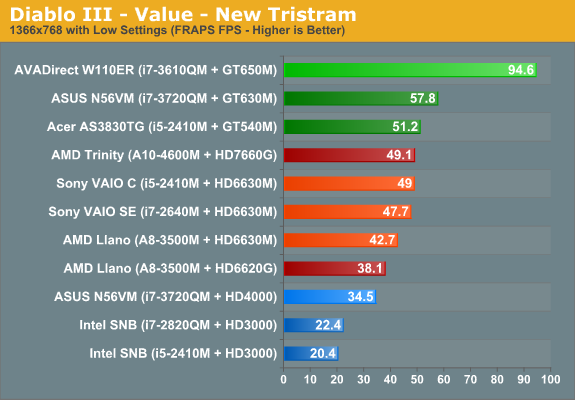
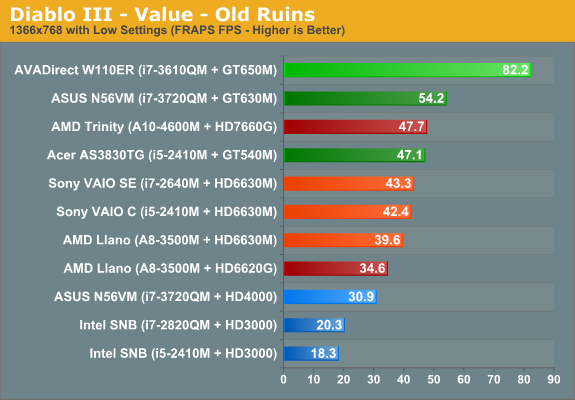
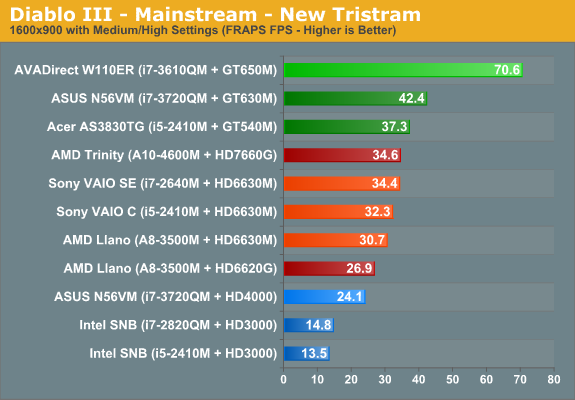

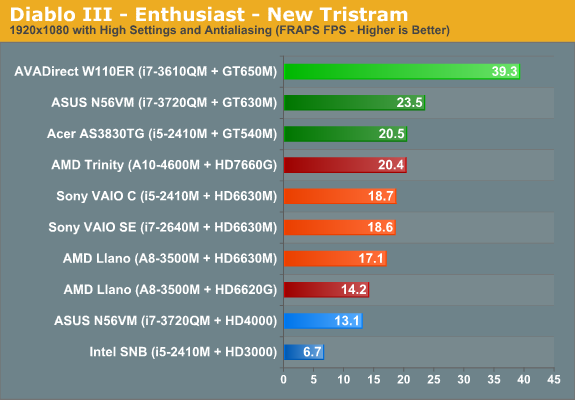
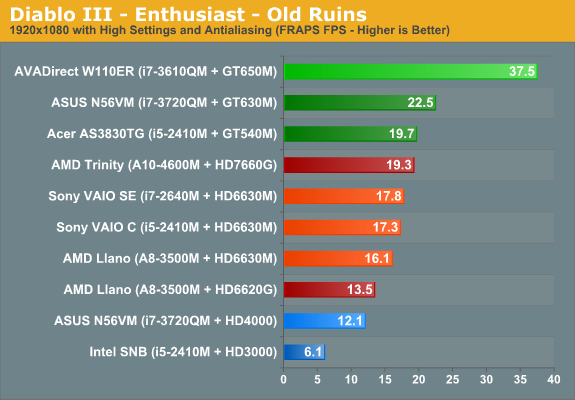
There’s plenty of data to cover, so let’s just start at the top with the discrete NVIDIA GPUs. Not surprisingly, the GT 650M powers through Diablo III without any issues; even at maximum detail and 1080p resolution, it’s still pulling nearly 40 FPS. The second set of GPUs, the GT 630M in the N56VM and the GT 540M in the Acer AS3830TG, are in theory supposed to be roughly the same performance. However, we've seen in the past that the Acer sometimes has issues with throttling, so potentially the GT 540M is running with a thermally constrained CPU in the AS3830TG. The charts above clearly show that the Acer can’t keep up with the Ivy Bridge solution. Either Diablo III is very good at using multi-core CPUs (doubtful, given what we saw with Blizzard’s StarCraft II, not to mention a quick look at Perfmon with Diablo III), or the Acer is once again not hitting higher clock speeds.
Update #2: So it appears that the ASUS N56VM is not running a lower clocked GPU; in fact, the opposite is true. NVIDIA's control panel reports 475MHz on the GPU core, 950MHz on the shaders. I've been a bit confused about the performance since day one, but several other utilities reported 475MHz as well, including GPU-Z. Interestingly however, I just ran GPU-Z with the sensor logging option while doing a FRAPS run in Diablo III. Instead of 475/950MHz, the sensors tab is instead reporting 797.3/1594.7MHz. Mystery solved: the GT 630M in the N56VM is actually clocked almost 20% higher than the stock GT 540M. That would explain the differences seen above.
We did a quick check and found that the typical CPU clocks for the i5-2410M during our test sessions typically ranged from 800MHz to 1.7GHz range, which you can see in the above image. (Side note: we also tested with ThrottleStop active, which is what the above chart shows; it was set to a 21X multiplier, but clearly that didn't work as intended.) The average clock speeds of the two cores during our test sequance are a rather slow 1200MHz and 1085MHz, so clearly the CPU isn't really providing the sort of clocks we usually see on i5-2410M. However, Diablo III doesn’t appear to need a ton of CPU performance; given the new information we have on the GT 630M clocks (see update above), it appears that Diablo III simply doesn't push the Acer hard enough to activate higher CPU clocks most of the time.
The second grouping of scores is mostly in red/orange, representing the AMD GPUs/APUs. For the red bars, Trinity and Llano both provide acceptable performance at our Value settings, and they’re still fast enough for the Mainstream settings—remember as we mentioned in the intro that Diablo III is actually quite playable at anything above 20 FPS. Once we hit our Enthusiast settings, both drop quite a bit; Trinity remains tolerable, but Llano definitely can’t keep up and you’d need to drop the Shadow Quality to Low at the very least for 1080p. Another really interesting piece of information we discover is that Trinity with it’s integrated GPU is still faster across the board than the HD 6630M (though there’s a possibility HD 6630M is being hurt by the outdated drivers). As for the three way HD 6630M comparison, CPU performance does appear to help a bit—the i7-2640M is typically slightly faster than the i5-2410M and A8-3500M—but the largest spread is only 15% at our Value settings; at Mainstream the gap drops a bit to 10-12%, while at Enthusiast it’s under 10%. Given the frame rates, the extra 15% never really means the difference between unplayable and playable; all three laptops with HD 6630M tend to handle up to our Mainstream settings quite well.
The final three lines are the blue Intel IGP results. HD 4000 with quad-core Ivy Bridge trails Llano across all settings, though it’s often close enough. Performance at Mainstream is a bit questionable; sure, you can play Diablo III well enough in our experience at 20-25 FPS, but it’s not going to be the smoothest result. Llano may only be 3-4 FPS faster at Mainstream, but that 12% performance increase is just enough to make the result a bit smoother. Your best bet with HD 4000 is ultimately going to be turning the Shadow Quality down to Low/Off, and then running at 1600x900.
As for Sandy Bridge’s HD 3000 IGP, perhaps the less said the better. Even at our Value settings, it only qualifies as tolerable, and at Mainstream it’s quite choppy—you could still play Diablo III at 13-18 FPS in a pinch, but I wouldn’t recommend it, and I doubt it would work well in multiplayer. Once frame rates drop below 15 FPS, it appears the engine starts to slow down rather than just skipping animations. Our New Tristram run usually takes around 20 seconds to complete (even at 20.1 FPS on the HD 4000), but when frame rates are in the low teens the time for the town run increases to around 30 seconds. Single-player is still possible, but that’s as far as I’d go—and it will take longer for everything you do, thanks to the moderate slowdown. When the HD 3000 drops below 10 FPS, what was sluggish takes a major nosedive; the town run required just over 60 seconds to complete, and the Old Ruins run that usually requires about 100-110 seconds clocked in at 308 seconds. Yup, there’s a reason we didn’t try suffering through the Enthusiast benchmark a second time on HD 3000!
Other Performance Tests
We did a few other tests to round out our performance information, though we didn't repeat the tests multiple times or run them on all of the systems. For one test, we used our Enthusiast settings but with Shadows on Low/Off with the HD 4000; the result of the testing is scores that are slightly better than the Trinity scores with Shadows on High. With Low shadows at 1080p, New Tristram scored 20.1 FPS and the Old Ruins scored 18.5 FPS; drop the shadows to Off and New Tristram runs at 27.1 FPS with Old Ruins at 24.8 FPS. In total, the difference between High Shadow Quality and Low Shadow Quality is over 50%, and going from Low to Off is another 35%. The other test was to use our maxed out settings but at 1366x768, again on the HD 4000. The frame rates were 17.3/16.4, or around 35% faster than at 1080p.
Given those results, it appears that Shadow Quality is the single most demanding setting, trumping even resolution. On HD 4000, you can basically double your performance at 1080p by turning off the shadows. Without doing in-depth testing (remember, we're looking at about five minutes to set up and run each benchmark setting, so I've already spent around 10 hours just doing the basic set of results shown above, not to mention testing other settings!), I can't say for certain, but my general impression is that the results are similar with other IGPs/GPUs.











87 Comments
View All Comments
JarredWalton - Sunday, May 27, 2012 - link
And funny enough, after additional investigation, the issue isn't throttling on the Acer but rather a higher clock on the GT 630M compared to the GT 540M. NVIDIA's updated specs page for the 630M lists 800MHz as the clock, but oddly their control panel is only reporting 475MHz on the ASUS. According to GPU-Z's Sensors tab, however, it really is running an ~800MHz core clock (1600MHz shaders), which accounts for the higher performance compared to the 672MHz GT 540M. I've updated the text in the article to explain this.ananduser - Saturday, May 26, 2012 - link
Suddenly those fancy expensive ultrabooks(Apple or otherwise) seem like extremely poor deals for tech enthusiasts. Then again they were always aimed at bloggers.DanNeely - Saturday, May 26, 2012 - link
... and enthusiasts who want an ultra portable that's a PC not a fondleslab, and which is faster than an atom.ananduser - Sunday, May 27, 2012 - link
No offense, enthusiasts(in the real sense of the word) are always more extreme than your average MBA wielding blogger. If they wanted something light they would spare no expense and would have gone with a VaioZ, or some crazy Japanese Fujitsu that is lithium made, or a moded Sony UX. PC hardware enthusiasm has nothing to do with Apple commodities that try to be as "safe" as possible.Impulses - Monday, May 28, 2012 - link
Suddenly? They were never marketed as gaming rigs, most don't even have dGPUs and Diablo 3 isn't even one of the 5 most demanding games this year. I dunno what you're getting at, ultrabooks are still great for the propose they're meant for. Can you get just as much done with an uglier/thicker/heavier $700 laptop? Sure, you might even get a dedicated GPU to go along with it... They're serving entirely different markets tho.ananduser - Monday, May 28, 2012 - link
Which is why I mentioned tech enthusiasts in my original comment. There's nothing that I dispute from your enumeration.futurepastnow - Saturday, May 26, 2012 - link
Or, perhaps I should say, a concern. You increase the detail setting and the resolution together.What about 1366x768 at high detail? Or 1920x1080 at low detail?
JarredWalton - Saturday, May 26, 2012 - link
I have to stick to a subset of the possible resolution/detail settings or I'd be testing a single game 24/7 for a week. I've already spent probably 20 hours benchmarking Diablo III, and let me tell you: running the same three minute sequence at least a dozen times per laptop gets to be mighty damn tedious. I did run tests at some other settings, which I commented on I believe, but here's a bit more detail.For example, on the N56VM, 1080p with all settings maxed but Shadow Quality set to Low results in performance of 20.1 FPS/18.5 FPS for our test sequences -- so that one setting boosted performance by over 50% compared to having all settings at High/Max. What's more, I also tested at max detail 1080p but with Shadow Quality set to Off, and the scores are 27.1/24.8 -- another 35% improvement over Low shadows. Everything else combined (e.g. 1080p but all other settings at low) only accounts for probably 20%. I could test that as well if you really want, but I have other things to do right now.
futurepastnow - Saturday, May 26, 2012 - link
I'm mostly thinking that a large majority of laptops sold, even now, have 1366x768 displays. It looks like all of the non-Intel laptops handle playable framerates with low detail at that resolution, so I'm curious how that performance falls as the detail goes up.In particular, can Llano and Trinity handle high detail at 1366x768? They are (or will be) sold in budget laptops that won't get high-res screens.
However, I understand the time constraints your working under. Thanks for the comparison, anyway.
kyuu - Saturday, May 26, 2012 - link
I agree with this. I understand time constraints, but honestly, the paradigm that's being followed here (and with a lot of reviews) is simply not representative of real-world usage. It's not the case that people play with low details at low resolutions and high details at high resolutions. *Especially* when you're dealing with laptops. Generally, you're going to have the resolution at the display's native resolution, and going to work with the settings from there.In any case, the article is still appreciated, and it's possible, at least, to make an educated guess at how the game will run at various resolutions and settings based on the presented info. Definitely going to grab myself a nice Trinity-powered laptop soon as one meeting my desired specs comes out.
Also, yet again we see that HD4000 does not match Llano, let alone exceed it, as I've seen some people spreading around.